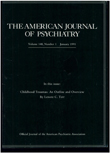DSM-III disorders in a large sample of psychiatric patients: frequency and specificity of diagnoses
Abstract
This study examined certain nosological features of DSM-III axis I diagnostic categories and subcategories as applied to 11,292 general psychiatric patients presenting for care, using a semistructured assessment procedure. The most frequently used major categories were affective, substance use, childhood-onset, and adjustment disorders. Secondary diagnoses were given to 26% of the patients. Male patients predominated in the categories of impulse-control, psychosexual, and substance use disorders, and female patients predominated in the categories of anxiety, affective, and somatoform disorders. Of the 329 five-digit subcategories available in DSM-III, 296 (90%) were actually used. Sixteen percent of the patients were given unspecific primary diagnoses.
Access content
To read the fulltext, please use one of the options below to sign in or purchase access.- Personal login
- Institutional Login
- Sign in via OpenAthens
- Register for access
-
Please login/register if you wish to pair your device and check access availability.
Not a subscriber?
PsychiatryOnline subscription options offer access to the DSM-5 library, books, journals, CME, and patient resources. This all-in-one virtual library provides psychiatrists and mental health professionals with key resources for diagnosis, treatment, research, and professional development.
Need more help? PsychiatryOnline Customer Service may be reached by emailing [email protected] or by calling 800-368-5777 (in the U.S.) or 703-907-7322 (outside the U.S.).



